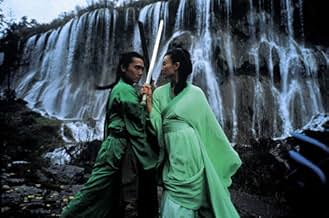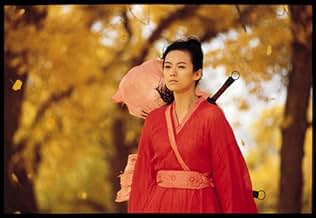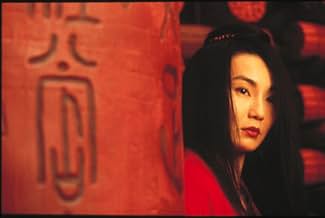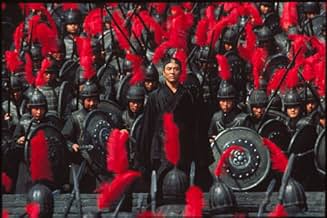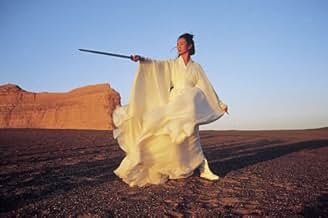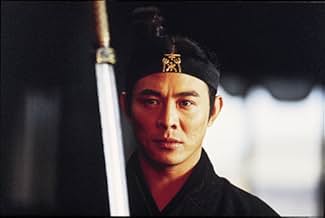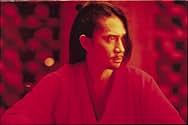El guerrero Sin Nombre llega al palacio del rey Qin y narra la historia de como luchó contra tres asesinos que aterrorizaban China.El guerrero Sin Nombre llega al palacio del rey Qin y narra la historia de como luchó contra tres asesinos que aterrorizaban China.El guerrero Sin Nombre llega al palacio del rey Qin y narra la historia de como luchó contra tres asesinos que aterrorizaban China.
- Dirección
- Guionistas
- Elenco
- Nominado a 1 premio Óscar
- 46 premios ganados y 48 nominaciones en total
- Broken Sword
- (as Tony Leung Chiu-Wai)
- Flying Snow
- (as Maggie Cheung Man-Yuk)
- Moon
- (as Zhang Ziyi)
- King
- (as Chen Dao Ming)
- Scholar
- (as Liu Zhong Yuan)
- Old Servant
- (as Zheng Tian Yong)
- Commander
- (as Zhang Ya Kun)
- Seven Qin Guards
- (as Hei Zi)
- Dirección
- Guionistas
- Todo el elenco y el equipo
- Producción, taquilla y más en IMDbPro
Opiniones destacadas
Comprising, but not limited to outstanding duelling with a variety of razor sharp implements and tongues, a kaleidoscopic background of intense colour and beauty, several tangents to keep you on your toes, an immense scale that befits the telling of such a story with an elegance seldom encountered in Western culture when it comes to films of this time and age, buttressed through outstanding performances by the lead actors all round - outstanding.
The imagery is unparallelled, simply draw-droppingly near perfect scenes, with bold and vibrant use of colour, symbolism and scenery. The fluent flow of the storyline, the delicate direction of the sword slicing action, the Chinese cultural concepts and the emotionally charged scenes between characters combine to produce a simply remarkable achievement.
This film has a few elements from Crouching Tiger Hidden Dragon, but is far, far superior in every way. The sleek direction from Yimou Zhang is so perfectly done, just imagine two martial arts experts ensuing in battle against each other, defying the laws of physics as we know it, and yet following them in 360 degrees in slow motion as one deflects a droplet of rain from one sword to the other, at the same time spinning and leaping over water... simply beautiful. The attack sequences are also superbly set, with hundreds of thousands of the King's warriors in formation, simultaneously firing enough arrows into the city which literally cover the sky, in addition to the viewer being able to watch the journey of a single arrowhead aimed during this event. The build up to the attack along with the unnerving tune of a Chinese stringed instrument help you, as the audience, to become firmly engrossed in your seat.
The individual martial arts is also second to none, for myself particularly to see the distant shots of the whole battle sequence showing the true skills involved with fighting, such as footwork, perfect timing,aggression, counter attacks and defence. Jet Li shows he is truly the grand daddy of martial arts. I cannot stress enough how much you need this film in your life.
The colourful imagery imposed by the director will take your breath away with luscious, vivid, bright, wind-blown,draped backgrounds as the setting for the important progression of the story. Even the story itself is brought to the audience in such a way which ensures your undivided attention, as there are twists in the tales and hidden plots which do not develop until the end of the film.Even short individual scenes are memorable due to their sheer awesome display of skill and speed.
This film even holds a political message which is relevant to all times, especially in today's American-lead world dominance. This film has absolutely everything - including an extremely sexy young Ziyi Zhang who simply is the biggest hype to come out of china since SARS.
This film was released in 2002, but this is certainly one of my all time favourites and will probably be the best film I see all year. I have never been more enthusiastic to pursue films in this genre in my life. For more action type enthusiasts who like more gore and violence check out 'Ong Bak', but for people who appreciate a fuller, visionary piece of martial arts filming, this will leave you speechless.
First, there are scenes of haunting beauty("Duel in the yellow forest" and "Turquoise autumn" to site a couple) that, like the best of impressionist paintings, are so affecting that you will forever see the world in a slightly different way having once beheld them.
Secondly, the overall message of the film is a provocative one. The claim is that a degree of human casualties and suffering may be the optimal path to a better world, especially when the alternative is equally brutal chaos. This is not a popular theme. It has become much more fashionable to be anti-war in all cases. And understandably so, since variations of this logic have often been used in the past to justify atrocities. But the film provides a crisp litmus test for avoiding delusion: action must be taken with a heart void of malice and an unwavering commitment to the broadest possible ultimate outcome of good for all. Can anyone live up to this standard? Several characters in the movie do, each in their own way. If the standard could be met, would the world be a better place? These are questions worth reflecting on that have not been dealt with, to this depth, in any film I'm aware of.
Kurosawa is here obviously in the story: it is half 'Rashomon' and half 'Ran.' But more important is Kurosawa's theory of film as a device to capture space. As with Parisian impressionist painters, the thing painted is not the point. It provides an origin only; the painting is about all the magical things that happen in the space between the subject and the viewers eye. The paintings, and Kurosawa's films are about that space.
Kurosawa invented the technique of shooting from very far away with a telephoto so as to flatten space, and at the same time creating (usually three) layers of space. Often, he would engage the space directly.
This masterful film is obsessive about the point and may be the most lush swim in dimensional space you are likely to find with the technology we have. Every shot is oriented around not the action, but the space that contains the action. Falling water, dust, lots of blown fabric and hair, feathers, arrows, even book tablets and those leaves! With lots of bamboo screens, all these are used to show the space, plus the usual fantastic mountains, clouds and forests - even at the end the Great Wall and of course the moving waves of soldiers and courtiers.
Many of the architectural shots are lifted from Welles' "Othello."
The matter is not lost in the copious allusions to mental space: the game of Go, music, calligraphy, politics, and love. All these are defined, exercised and conflated with one another in terms of space and the intrigue of space with a little more effort in the latter items on the list. Then, waving lamps are used to make 'murderous intent' spatial.
Unlike 'Crouching Tiger' which this resembles not at all, the camera is static, not dancing. Where Lee emphasized the ballet of the fight by engaging his camera, Zhang stands back in the space. Where Lee conceives fights not among the participants but their masters, Zhang shows us not the fights, but the battles among the true worlds of the fights - the worlds of different colors.
What we see could be the imaged Go game, or the imaged fight within it, or the imaged story Nameless tells, or the one the King tells and on and on with nestings of imaginations.
Every nation creates their own movie to explain themselves. We in the US seem to like more militarist stuff. Except for the thuggish motive (my war for my kind of peace), we would do well to have stories about stories like this one through four layers until they reflect back on the origin. Complex story space in rich real space.
If you are going to see this, you really must see 'In the Mood for Love,' which features Broken Sword and Flying Snow in something of the same relationship they have here. It is one of the best films ever made and truly spatial in a purely Chinese manner. It will completely transform your enjoyment of this.
Ted's Evaluation -- 3 of 3: Worth watching.
¿Sabías que…?
- TriviaThe "red fight" between Moon and Flying-Snow was filmed in a forest in Mongolia. Director Yimou Zhang had to wait until the leaves turn yellow, and hired local nomads to gather even more yellow leaves in order to cover the ground completely. In fact, he was so fanatic about the leaves, that he had his crew separate the leaves into four different "classes" which were each put at increasingly farther lengths from the camera.
- ErroresAt the beginning of the movie, subtitles state that China was divided into seven warring states. At the end, the subtitles then state that "the King of Qin" unified China, without specifying which one. Historically, the king that was the one to unite all of the Chinese states was Ying Zheng (later changed name to Shi Huang Di) who inherited the throne from his deceased father at age 13 (as opposed to the age of the king in the movie). At the time, Ying Zheng began to rule China, the seven states were already reduced to two larger states (Qin and Chu) which was later dominated by Qin when Ying Zheng was 22 years old. It is therefore impossible for the same king shown in the movie to be the king that united all the Chinese states, although the end-note is semantically correct.
- Citas
King of Qin: I have just come to a realization! This scroll by Broken Sword contains no secrets of his swordsmanship. What this reveals is his highest ideal. In the first state, man and sword become one and each other. Here, even a blade of grass can be used as a lethal weapon. In the next stage, the sword resides not in the hand but in the heart. Even without a weapon, the warrior can slay his enemy from a hundred paces. But the ultimate ideal is when the sword disappears altogether. The warrior embraces all around him. The desire to kill no longer exists. Only peace remains.
- Versiones alternativasThe Director's Cut was 107:15 minutes, compared to the theatrical version at 96:23 minutes.
- ConexionesEdited into Ying xiong: Cause - The Birth of Hero (2002)
Selecciones populares
- How long is Hero?Con tecnología de Alexa
- Why did the king tell his own version of events if he didn't even know what happened until just a few moments ago when he realized Nameless' plan?
- Was the king a dictator?
- Did the king really had to kill Nameless at the end?
Detalles
Taquilla
- Presupuesto
- USD 31,000,000 (estimado)
- Total en EE. UU. y Canadá
- USD 53,710,019
- Fin de semana de estreno en EE. UU. y Canadá
- USD 17,800,000
- 29 ago 2004
- Total a nivel mundial
- USD 177,395,557
- Tiempo de ejecución1 hora 47 minutos
- Color
- Mezcla de sonido
- Relación de aspecto
- 2.35 : 1
Contribuir a esta página





